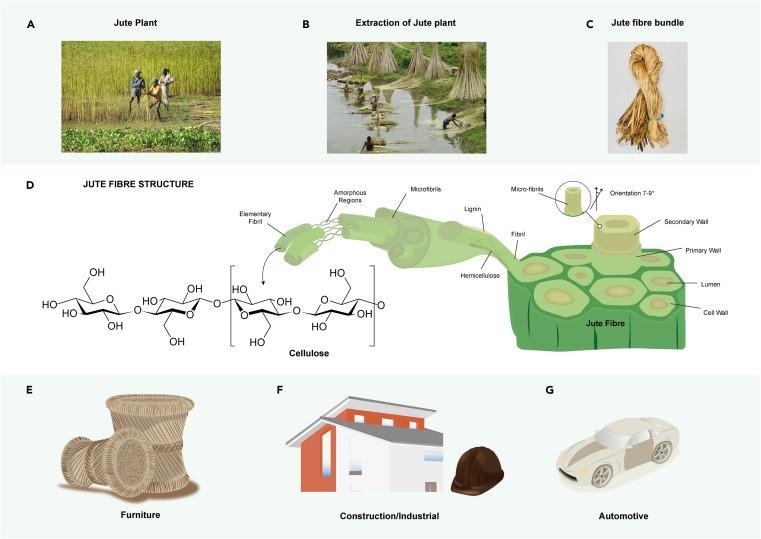Natural Fiber Reinforced Composites (FRC) have piqued the interest of researchers; particularly, natural Jute FRC is a reliable, eco-friendly, sustainable, and cost-efficient alternative to synthetic FRC according to the latest research published in iScience. Physiochemical modifications, as well as graphene-based alterations of jute fibers, and their effects on the tensile characteristics of jute FRC, have been thoroughly addressed.

Study: The effect of surface treatments and graphene-based modifications on mechanical properties of natural jute fiber composites: A review. Image Credit: TASER/shutterstock.com
Importance of Natural Fiber Reinforced Composites
Reusable and recyclable natural fiber-reinforced composites (FRC) have attracted the attention of researchers owing to their reduced carbon footprint, notably lower carbon pollution and petroleum usage, reduced price and density, and simplicity of production. The usage of such fibers might provide a hitherto unseen mixture of rigidity, hardness, and durability at a low population density.
As a result, natural FRCs may be employed as lightweight and ecologically sound materials to displace glasses, carbon, or other synthesized FRCs in a variety of sectors such as aerospace, architecture, and domestic items. Jute is among the most utilized naturally occurring fibers used for their synthesis.
Introduction to Jute and Jute Fibers
Jute is a sort of bast fiber that is derived from a plant. Corchorus capsularis (white jute) and Corchorus olitorius (black jute) are the two most common species of jute (Tossa jute). Jute plants require simple grassy soil, equatorial rainfall (125–150 mm per month), mild temperatures (20–40°C), and high relative humidity (70–80%) for optimal development. Jute fiber is produced from the plant's bast. Retting, stripping, washing, drying, and packaging are all steps in the jute fiber process of extraction. The retting procedure is done out either biologically or chemically with the use of chemicals.

Introduction to Jute. (A) Jute plant (B) the extraction of jute fibers from the plant (C) jute fibers bundle and (D) the structure of jute fiber. Applications of jute fiber and its composites: (E) furniture, (F) constructions, and (G) automobiles. Image Credit: Islam, M. H. et al., iScience
Applications of Jute Fiber
Jute has historically been used to make packing wraps such as Styrofoam, bagging, ropes, cordage, and carpeting underlay fabric. Jute fibers have also been employed in thermosetting elastomers as well as thermoplastic composites as additional reinforcement. Such fibers are durable, renewable, and abundant, which has sparked great research attention in fiber-reinforced composites technologies over the years due to their lower ecological consequences than artificial fiber-reinforced composites.
Limitations of Jute Fibers
Owing to the existence of substantial quantities (20 wt. percent – 50 wt. percent) of non-cellulosic components such as lignin and hemicellulose, jute fibers have inferior tensile characteristics and bonding strength when supplemented with a matrix. The inclusion of such materials reduces fiber crystalline nature and wettability.
The constraints of employing jute fiber as composite supplements include low compressive strength due to the fiber's hydrophilic nature, weak fiber-matrix interfacial adhesion, and weak hydrophilicity. As a result, jute fiber surface treatment is necessary. The elimination of contaminants such as wax, hemicellulose, and lignin, as well as the addition of additional chemicals onto the fiber's surface, might improve the interface adhesion and humidity resistance of the fiber matrix.
Importance of Graphene and Its Derivatives
The remarkable mechanical qualities of graphene and its derivatives such as graphene flakes (G), graphene oxide (GO), and reduced graphene oxide (rGO) have recently received much interest for superior composite applications. Graphene derivatives (GO and rGO) in stable suspensions might be mass-produced in large quantities.
Furthermore, due to their inherent functional groups, such materials have superior chemical responsiveness as well as storing and handling attributes. Furthermore, graphene-based jute FRC has been created for large-scale multifunctional smart nanocomposite technologies, as evidenced by excellent electromagnetic disturbance blocking and de-icing implementations.
Graphene Modified Jute Fibers
The research revealed that Tensile characteristics and interlaminar strength (ILSS) of GO (1%), rGO (0.5%), and GnP (10%) treated solitary jute fiber hybrids were enhanced by 236 %, 97 %, and 164 %, correspondingly, when compared to pure jute fiber composite materials. The presence of a large quantity of oxygen functional group is connected with such a massive improvement in IFSS with GO.
Tensile strength increases from 295 MPa to 575, 814, and 474 MPa, while Young's modulus increases from 30 GPa to 48, 78, and 52 GPa for 1 percent GO, 0.5 percent rGO, and 10% G flakes coated jute fiber.
The Elastic modulus, compressive strength, and tensile strain of the rGO-based jute FRC improved with increasing rGO concentrations, with 0.5 percent rGO coated jute epoxy composites achieving the biggest boost.
In short, with greater environmental worries over petroleum synthetic fabrics, researchers have concentrated on degradable fibers derived from renewable sources. Biodegradable, recyclable, and inexpensive nanomaterials for structured nanocomposite purposes that offer remarkable flexibility, stiffness, durability, and versatility are gaining popularity.
Bibliography
Islam, M. H. et al., 2021. The effect of surface treatments and graphene-based modifications on mechanical properties of natural jute fiber composites: A review. iScience. 103597. Available at: https://www.cell.com/iscience/fulltext/S2589-0042(21)01567-4?_returnURL
Disclaimer: The views expressed here are those of the author expressed in their private capacity and do not necessarily represent the views of AZoM.com Limited T/A AZoNetwork the owner and operator of this website. This disclaimer forms part of the Terms and conditions of use of this website.